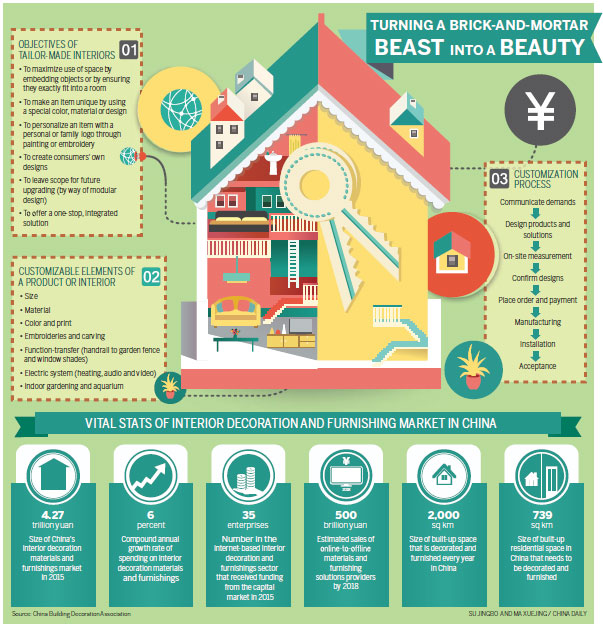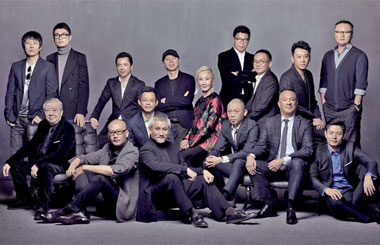Making every interior inch count
Updated: 2016-04-15 08:55
By Wu Yiyao(China Daily Europe)
|
|||||||||
High housing prices are pushing space-conscious homebuyers to spend more on decoration and custom-made furniture
Yang Hui, a 32-year-old Shanghai-based accountant, has been looking for a shelf that can store both his collection of manga model kits and his wife's collection of lipstick and nail polish sets, and other assorted objects, for some time now. The newlywed couple needed it well before May, when they move into their new apartment.
"Finding the right shelf is the most difficult part of settling in a new home. The furniture needs to exactly fit the size available in the not-so-spacious room. We don't want to waste even a square inch. The shelf must function as a display cabinet as well that can store hundreds of small pieces. Also, it has to blend in well with the room's main color, which is chestnut. My wife and I visited many furniture stores and malls, but couldn't find the right shelf," Yang says.

In late March, the young couple decided to get a shelf custom-made by a furniture maker in Shanghai. The store South Shaanxi Road promised a perfect fit for 5,600 yuan ($867; 760 euros), and it would take two weeks to deliver.
The price appeared steep, but the couple agreed. They shared exact specifications on size, shape, material, color and paint type. They even drew a sketch to explain their ideas.
The furniture designer then used software to visualize the shelf, which the couple found satisfying. Two weeks later, the three-month shelf-hunting mission arrived at a happy ending.
More and more consumers like Yang are opting to install custom cabinets, furniture, wardrobes and fittings. Such products' market size may reach 160 billion yuan by the end of 2020, according to a report in March by the China National Furniture Association.
Given current high property prices and resulting space limits, consumers feel an acute need to optimize residential interiors in terms of quality and comfort. Custom interiors also help make homes unique and personalized. Interior design has become "a fast-growing sector in recent years", the association report says.
"Decades ago, almost everyone in urban areas used to live in an apartment that was close to his or her workplace. The space, floor plan and even the color of walls were similar and predictable. Furniture made by carpenters came in a limited number of models and designs," says Han Xian, a 42-year-old interior designer who works for Shanghai Dijia Interior Design.
Han is one of the first generation of interior designers in China. He entered the trade around 1995, when the sector first became popular nationwide. Han says consumers are now exposed to many housing styles and technologies. Modern supplies offer consumers a much wider range of choices.
"Customization can be subcategorized into several modes, based on customers' demands. Some want a particular color. Others want a certain product in a specific size. Some like to give shape to a concept or theme like 'Mediterranean holiday'. And some want the interiors to be functional, like rooms that encourage children to read, or a cat-friendly kitchen," Han says.
Francois-Xavier Lienhart, CEO of Lixil Group, a Japan-based construction materials supplier, says experience-oriented production and design are dominating China's higher-end interior design and custom furniture market.
"Take the kitchen, for example. There can be thousands of details that need to be taken into consideration when designing kitchenware, stoves, cupboards and sinks. Cooking habits, dining habits, the number of family members and family structure will all influence the usage, floor plan and necessities in the limited space," he says. "In more affluent families with spacious kitchens, the place is not only a space for preparing food but also a space for communication and quality time together. So, the safety of children must be embedded in every detail of the kitchen design."
To reduce the risk of complaints against designers and suppliers, communication is key, which can produce good results in custom interior design, according to market experts.
Zhu Yuanmin, marketing director with Beijing-based Easy Home Ltd, says because customization of interior design and furnishing involves a lot of steps, it is essential to include every detail explicitly in the contract with the consumer, to ensure efficiency and transparency in the entire design, manufacturing and installation process.
Such a contract also helps consumers because it avoids misunderstandings, Zhu says.
wuyiyao@chinadaily.com.cn
Today's Top News
Passage to piraeus
In the hall of the great frescoes
World Bank joins AIIB on financing for joint projects
GM seeds to get oversight
Russia-China ties benefit both countries, peoples
China, UK showcase best books in London
Hello, China! Stephen Hawking debuts Weibo account
Manila set to restart revamp of airport in S China Sea
Hot Topics
Lunar probe , China growth forecasts, Emission rules get tougher, China seen through 'colored lens', International board,
Editor's Picks

|

|

|

|

|

|







